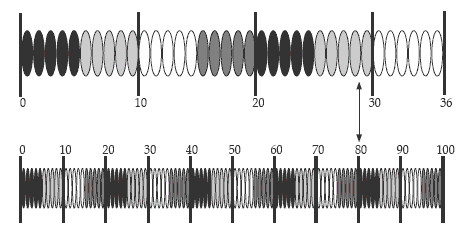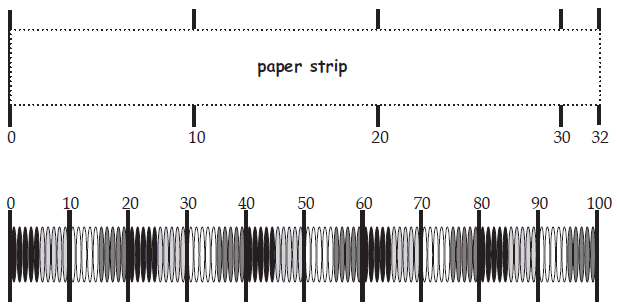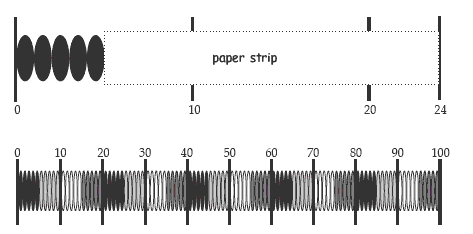Solve problems involving ratios.
Number Framework Stage 8
Using Materials
Begin with the lesson sequence described in Hotshots (page 47). The aim of this lesson is for students to gain an algebraic understanding of what is occurring with the quantities in a percentage problem as they perform calculation steps. For this purpose, it is important to use problems in which scaling up to 100 or common factor strategies do not work easily. This lesson also extends the location of the unknown in such problems.
It is important that students have access to calculators for this lesson.
Pose three different types of problem using the percentage strips for support:
1. Percentage unknown
“Jordan takes 36 free throws and lands 29 of them. What is his shooting percentage?” (29/36 = ? %).
Encourage the students to estimate the percentage visually or by using their common factor strategies, e.g., “30 out of 36 is five-sixths …” or “three times 35 is a bit more than 100, so 29 out of 36 is a bit less than three times 29 is 87”. Require the students to make qualitative adjustments to their estimates by asking questions such as “Is your estimate too high or too low? Why?”
Ask the students to represent the problem as an equation, i.e., 29 ÷ 36 = ?%. As students select calculation steps, which they will perform using a calculator, ask them to justify their calculations, referring to the strips as they do so. They will often select calculations that are not useful, e.g., “divide 100 by 29”, and access to the strips helps their self-regulation. Where calculations are productive, question the students about what each step is doing:
Student: I divided 100 by 36.
Teacher: What did 100 ÷ 36 = 2.7 (recurring) tell you?
Student: The percentage each shot was worth
Or:
Student: I divided 29 by 36.
Teacher: What did that tell you?
Student: It told me the percentage as a decimal fraction (0.80555 …)
Other problems that might be modelled with the strips are:
“Daniel kicked 16 shots at goals. He got 11 kicks over. What was his kicking percentage?”
“Ronaldo took 32 spot kicks this season. He scored from 25 of those kicks. What was his penalty shooting percentage?”
2. Part unknown
“Cindy had to answer 32 questions for her drivers’ licence. She scored 81%. How many questions did she get right?”
In modelling this problem, it is important that the 32 strip is aligned with the 100 strip but is turned over or masked with a paper strip so that it cannot be seen.
As with problem type 1, ask the students to estimate their answer fi rst, represent the problem with an equation, and then perform calculation steps to fi nd the answer.
Equation: ? ÷ 32 is approximately 81%
Student: I found 100 ÷ 32 = 3.125.
Teacher: What does that tell you?
Student: Each question is worth 3.125 percent.
Teacher: What calculation will you do then?
Student: 81 ÷ 3.125 = 25.92.
Or:
Student: 81% is 0.81, so I found ? ÷ 32 = 0.81. I did 0.81 x 32 = 25.92.
Teacher: So did Cindy sit 25.92 questions?
Student: She sat 26 questions. The percentage was rounded.
3. Whole unknown
“Zoe noticed that five of the lambs were black. That was about 21 percent of all the lambs in the paddock. How many lambs were in the paddock?”
In modelling the problem, the 24 and 100 strips need to be aligned, but the part of the 24 strip from 5 to the end is masked with a paper strip.
Equation: 5 ÷ ? is approximately 21%.
Student: 21 percent is about 20 percent or one-fifth. So I estimated that five is one fifth of the total. So there must be about 25 lambs.
Teacher: Will the number of lambs be more or less than 25?
Note that whole unknown problems require students to have an algebraic understanding of equality, order of operations, and inverse. This is revealed through the calculation steps as actions on the equation:
5 ÷ ? = 21 ÷ 100 or 21% x ? = 5
5 x 100 ÷ ? = 21 21 ÷ 100 x ? = 5
500 ÷ ? = 21 21 x ? = 5 x 100
500 = 21 x ? 21 x ? = 500
500 ÷ 21 = ? ? = 500 ÷ 21
Using Imaging
Provide the students with problems of all three types, percentage, part, and whole unknown. Use a double number line as the image of each problem and encourage the students to create their own equations and diagrams.
1. Percentage unknown
“Mani took 37 shots and landed 26 of them. What was her shooting percentage?”
Equation: 26 ÷ 37 = ?%
Image:

2. Part unknown
“Mani took 43 shots at goal. She got in 79% of them. How many of her shots went in?”
Equation:? ÷ 43 is approximately 79% or 79% x 43 = ?
Image:

3. Whole unknown
“Mani took a number of shots at goal. She got in 14 of them. That was about 45%. How many shots did she take?”
Equation: 14 ÷ ? is approximately 45% or 45% x ? = 14
Image:

Also provide problems of these types that require a whole-to-whole comparison. This allows percentages that are over 100%.
“Kim scored 23 goals, and Todd scored 38 goals. Compare Todd’s number of goals with Kim’s as a percentage.” (38 ÷ 23 = 165%)
“Shangzhi bought a gold coin. It is now worth $73, which is 155.3% of the price he paid. What did Shangzhi fi rst pay for the coin?” (73 ÷ ? = 155.3%, ? = 47)
“On Kylie’s farm, there was a 147% lambing percentage. If there were 87 ewes, how many lambs were born?” (? ÷ 87 =147%, ? = 128)
Using Number Properties
Students will demonstrate a generalised understanding of how to solve percentage problems when they can perform correct calculation steps and justify their steps in terms of the quantities involved. Equations and diagrams such as double number lines or strips are still important in representing problems and for easing cognitive load.
Suitable problems might be:
“Tui got 89 bins of apples from her orchard this year compared to only 33 bins last year. By what percentage did her production increase this year?” (89 33 = 56. 56 ÷ 33 × 100 = 169.7%)
“This year, 53% of the babies born were boys. If 42 000 boys were born, how many babies in total were born?” (53% × ? = 42 000; ? = 42 000 ÷ 53%; ? = 79 245)
“77% of the jobs advertised in the newspaper required computer skills. There was a total of 483 jobs advertised. How many did not mention any need for computer skills?” (? ÷ 483 = 23%, so 23% x 483 = ?, ? = 111)


